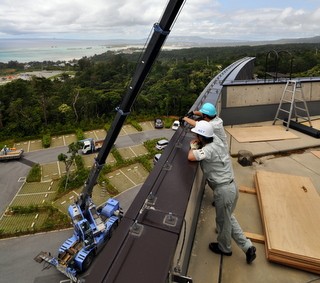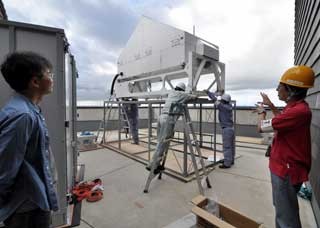New weather radar test conducted at OIST
By Micheal E. Cooper
When you move to Okinawa, everyone tells you not to trust the weather forecasts; the island weather is fickle, rain drenching the laundry you just put out to dry. However, for the next month, the Japan Aerospace Exploration Agency (JAXA) and Japan's National Institute of Information and Communications Technology (NICT) will use parts of the OIST Onna campus in experiments which may lead to advances in weather forecasting and flood prediction.
JAXA and NASA are collaborating on the development of the Global Precipitation Measurement (GPM) satellite to succeed the groundbreaking Tropical Rainfall Measuring Mission (TRMM) satellite. TRMM produces a 3D view of rainfall in a limited area centered on the equator, but GPM will increase the detail and range of this information to offer a more accurate, more current image of all the precipitation – from fine mist to snow and ice – over the entire globe.
One of the many new technologies in this satellite is the Ka Precipitation Radar” (KaPR), the development of which is being headed by JAXA and NICT. “Ka” refers to the “Ka band” of radar frequency, which is around 35GHz; this project is the first use of this bandwidth in a weather satellite, so researchers must test the accuracy and range of KaPR so that they can adjust the algorithms used to process the data obtained from the satellite.
Like older types of weather radar, KaPR operates by sending out radar waves which bounce back when they collide with particles of precipitation like rain, revealing the size and amount of precipitation in the area scanned. KaPR can see much more detail than other radar, detecting much smaller droplets, even down to fine mist. The drawback to this increased sensitivity is the fact that the waves deteriorate more quickly when they pass through precipitation.

In order to maximize the benefits of this new radar, researchers are conducting tests on the ground to understand KaPR’s weaknesses and use this knowledge to optimize the algorithms that will process the satellite’s data. JAXA Earth Observation Research Center (EORC) Associate Research Director Dr. Shuji Shimizu summarized the objective of the tests as follows: “The Ka band deteriorates in the rain, so while the device is still on earth, we want to understand what size and shape of precipitation causes KaPR to deteriorate by how much, and so on.”
In order to gather data on KaPR performance, the JAXA-NICT team have installed two KaPR testing units – one on the roof of the Lab 1 building at OIST, and the other on the roof of the NICT facilities in Onna Village. The two KaPR testing units are set to measure rainfall in the area over OIST Seaside House, where a third, different device has been installed which measures rainfall directly above it using an advanced video system. These three devices will measure the rainfall in the same piece of sky and transmit this information to JAXA and NICT, where developers will analyze it and further improve the technology.
While the GPM project will almost certainly result in more reliable weather forecasts, the significance is far greater than just knowing when to bring an umbrella. The wider geographical range and greater accuracy of the information made available is expected to ultimately lead to practical advances like the development of better water resource management, river control, irrigation systems, and methods for accurately predicting the severity and location of floods. Understanding weather in general and issues like global warming in particular require accurate data about the entire climate system, and GPM is a major step in obtaining this data. OIST is happy and honored to play even a minor role in supporting such an ambitious and crucial undertaking.
















